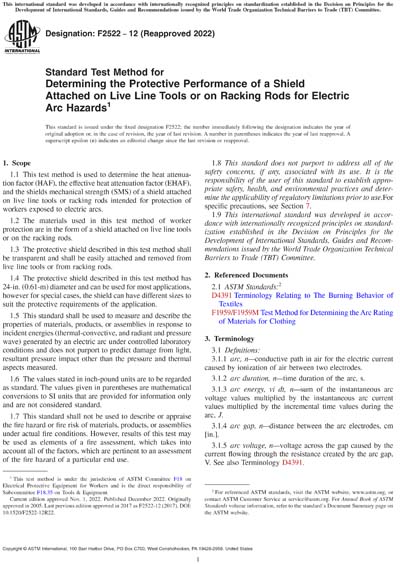Most recent
ASTM F2522-12(2022)
Standard Test Method for Determining the Protective Performance of a Shield Attached on Live Line Tools or on Racking Rods for Electric Arc Hazards
1.1This test method is used to determine the heat attenuation factor (HAF), the effective heat attenuation factor (EHAF), and the shields mechanical strength (SMS) of a shield attached on live line tools or racking rods intended for protection of workers exposed to electric arcs.
1.2The materials used in this test method of worker protection are in the form of a shield attached on live line tools or on the racking rods.
1.3The protective shield described in this test method shall be transparent and shall be easily attached and removed from live line tools or from racking rods.
1.4The protective shield described in this test method has 24-in. (0.61-m) diameter and can be used for most applications, however for special cases, the shield can have different sizes to suit the protective requirements of the application.
1.5This standard shall be used to measure and describe the properties of materials, products, or assemblies in response to incident energies (thermal-convective, and radiant and pressure wave) generated by an electric arc under controlled laboratory conditions and does not purport to predict damage from light, resultant pressure impact other than the pressure and thermal aspects measured.
1.6The values stated in inch-pound units are to be regarded as standard. The values given in parentheses are mathematical conversions to SI units that are provided for information only and are not considered standard.
1.7This standard shall not be used to describe or appraise the fire hazard or fire risk of materials, products, or assemblies under actual fire conditions. However, results of this test may be used as elements of a fire assessment, which takes into account all of the factors, which are pertinent to an assessment of the fire hazard of a particular end use.
1.8This standard does not purport to address all of the safety concerns, if any, associated with its use. It is the responsibility of the user of this standard to establish appropriate safety, health, and environmental practices and determine the applicability of regulatory limitations prior to use.For specific precautions, see Section 7.
1.9This international standard was developed in accordance with internationally recognized principles on standardization established in the Decision on Principles for the Development of International Standards, Guides and Recommendations issued by the World Trade Organization Technical Barriers to Trade (TBT) Committee.
Content Provider
ASTM International [astm]






